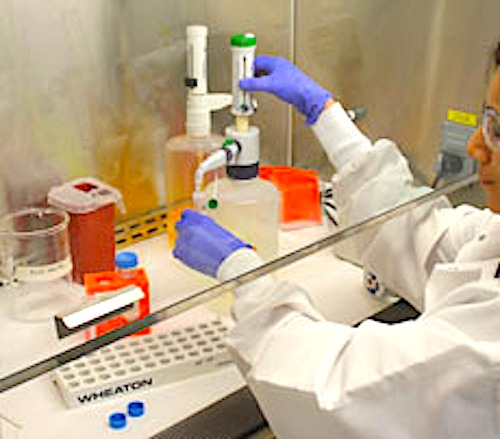
CONCORD, NH – New Hampshire is one of six states recently awarded a biomonitoring grant from the U.S. Centers for Disease Control and Prevention (CDC). The five-year award provides $5,162,497 million to enhance the Public Health Laboratories’ (PHL) Biomonitoring program. This grant will allow the PHL to analyze lead poisoning interventions, human health impacts from flooding, Berlin area environment impacts, and changes in contamination levels after preventative interventions.
Biomonitoring is the direct measurement of environmental chemicals in people’s blood and urine, indicating the amount of chemical that actually enters the body from all environmental sources. The CDC grant will enhance the PHL’s ability to determine whether residents have been exposed to certain contaminants, which will help identify at-risk population groups and assess the needs of those groups.
“To be one of only six states to receive this comprehensive grant is a confirmation of capabilities of our laboratorians to help people in the Granite State,” said Dr. Christine Bean, Director of the New Hampshire Public Health Laboratories. “This grant allows the Biomonitoring program to continue our work in an effort to understand the relationship between human health and exposure to environmental contaminants. We thank the CDC for the opportunity.”
The PHL and the Biomonitoring program will utilize the CDC grant funds on the following projects:
- NH PHL will work with the DPHS Healthy Homes Lead Program and families of children that present with elevated blood lead levels, following up two years later to see if interventions have reduced the level of lead in their blood.
- To prepare for emergencies, testing will determine what private wells and people are most at risk during high precipitation and flooding events.FEMA flood map and United States Geological Survey precipitation data will identify areas with highest risk and the data generated will provide a baseline for comparison after a flooding event.
- In Northern NH, the Berlin area is less resilient and has an EPA superfund site that contains mercury, dioxins, and other chemicals. This Biomonitoring project will determine vulnerabilities for area citizens by testing for chemicals to see if they differ from the average population in NH or the nation. Studies will include analyzing Volatile Organic Compounds (found in items such as liquid fuels, paints/varnishes, and cleaning and disinfecting products), per- and polyfluoroalkyl substances (PFAS), pesticides, herbicides, and metals.
- The final project will include follow-up analysis of this year’s NH Tracking and Assessment of Chemical Exposures Study (2019 NH TrACE), a statewide look at many different metals, pesticides, per- and polyfluoroalkyl substances (PFAS), and other chemicals such as tobacco smoke in NH residents. In 2024, five years after the first assessment, an additional study will determine if reductions in the contamination levels have occurred after preventative intervention (2024 NH TrACE) and will include additional contaminants of concern (VOCs, PAHs, mercury).
BiomonitoringNH will use the funding to conduct both targeted and surveillance investigations, and purchase laboratory equipment and supplies. New Hampshire toxicologists will conduct the laboratory analyses and work with epidemiologists to determine and communicate exposure risks of New Hampshire residents. CDC program staff will provide technical support and training for the state program. NH is a member of the National Biomonitoring Network that also provides peer support from members.
The data from these analyses will be useful in determining state-specific background levels of contaminants, identifying emerging concerns, prioritizing resources, and evaluating public health interventions. Biomonitoring data from New Hampshire will provide valuable information to the Department of Health and Human Services, Division of Public Health Services and other state agencies such as the Department of Environmental Services.
Learn more about the NH Biomonitoring program here.







